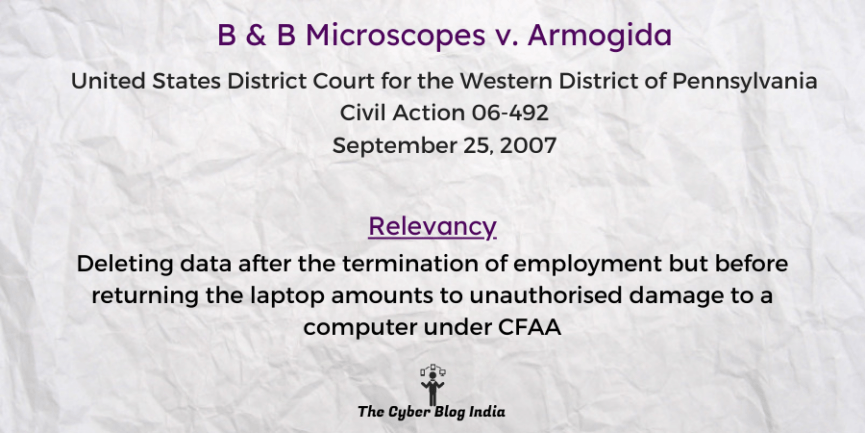B & B Microscopes v. Armogida

B & B Microscopes v. Luigi Armogida
532 F.Supp.2d 744
In the United States District Court for the Western District of Pennsylvania
Civil Action 06-492
Before Chief District Judge Ambrose
Decided on September 25, 2007
Relevancy of the Case: Deleting data after the termination of employment but before returning the laptop amounts to unauthorised damage to a computer under CFAA
Statutes and Provisions Involved
- The Pennsylvania Uniform Trade Secrets Act, 12 P.S. § 5302
- The Computer Fraud and Abuse Act, 18 U.S.C. § 1030
Relevant Facts of the Case
- The plaintiff is in the business of selling microscopes, consisting of very sophisticated imaging and microscope equipment, with costs in hundreds of thousands of dollars. Its business operations have evolved over time, and the plaintiff also offers an imaging software package for customised imaging solutions to its customers.
- While the defendant was initially hired to sell customised solutions, the plaintiff also gave him the responsibility of developing custom solutions that it did not have.
- The parties signed an Employment Agreement in 1998. This agreement was silent on the assignment of intellectual property rights. However, there was a non-compete clause for 12 months after the termination. The agreement also restricted the defendant from deleting any records of sales, services, customer lists, or in any other form.
- One of the plaintiff’s employees accompanied the defendant to the Ohio Bureau of Criminal Investigation (OHBCI). OHBCI has been the plaintiff’s client for over ten years. After the visit, the defendant discussed a potential product idea to detect sperm on slides via scanning with a co-owner of the plaintiff.
- Once the system was installed, OHBCI and B&B agreed that the system needed more work. The defendant kept working on the system while providing regular updates to the owners of the plaintiff company.
- In March 2006, he prepared a development proposal for the owners of the plaintiff company. However, he had already filed a patent application in his own name in January 2006. He had not disclosed this to the plaintiff at the time.
Prominent Arguments by the Counsels
- The plaintiff’s counsel submitted that the forensic examination revealed that the defendant had deleted or overwritten every file related to the KPICS system. He also deleted files related to other products and services of B&B.
Opinion of the Bench
- The defendant acted deceptively by hiding information about the patent application he filed in his own name. While there is no express assignment clause, B&B is the rightful owner of the KPICS system based on all the circumstances in the present case.
- B&B undertook reasonable steps to maintain the secrecy of their systems by purchasing HASP keeps to prevent reverse engineering. However, it is not clear if the defendant actually installed those keys. The defendant went on to market the system as his property to the State of Utah and multiple forensic scientists in Ohio. Therefore, the defendant has misappropriated the plaintiff’s trade secret and deprived it of its ability to use the trade secret.
- The defendant’s conduct is not without authorisation or exceeds authorisation. However, his actions led to unauthorised damage to a computer, as given under Section 1030(a)(5)(A)(i).
Final Decision
- The court ordered the defendant to assign the patent application in the plaintiff’s name. Further, the defendant must pay damages, reasonable legal fees, and costs to the plaintiff.
